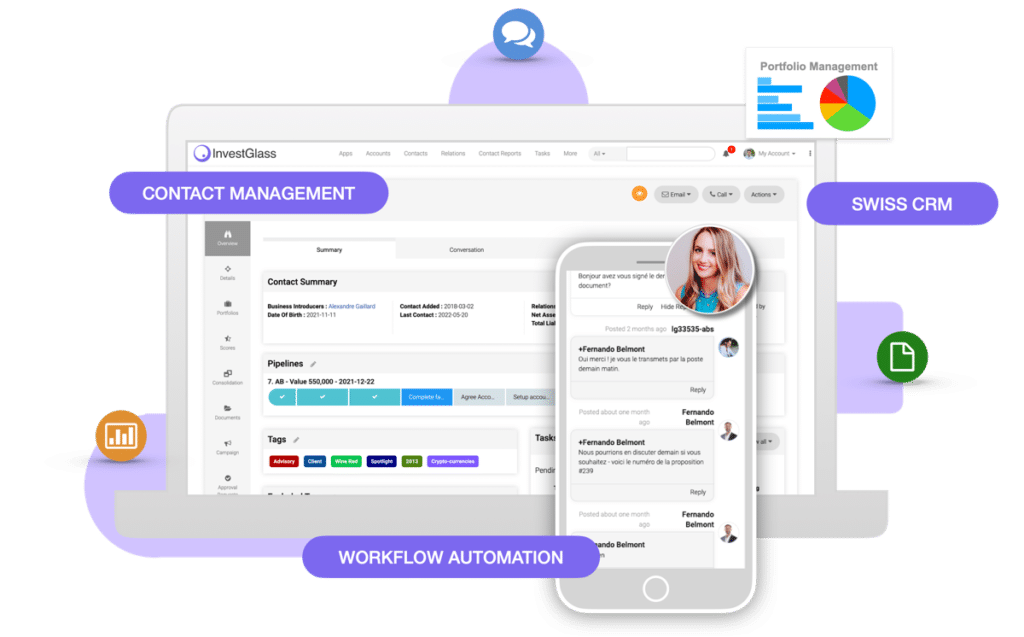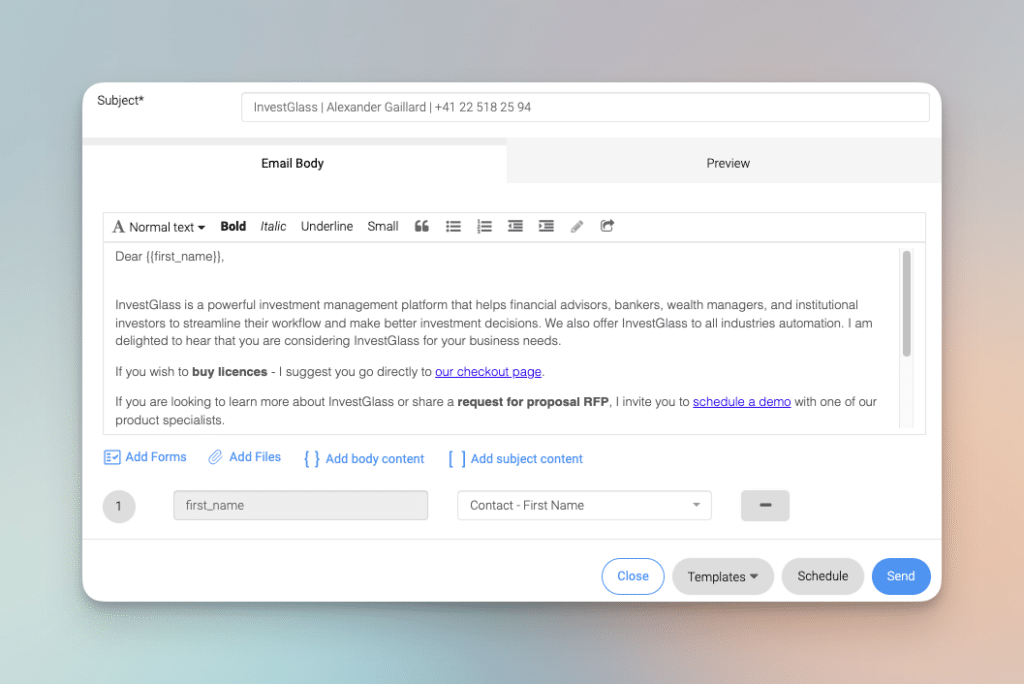
CLM vs CRM in Financial Client Engagement
Written by InvestGlass on .
Introduction
In the realm of financial services, the debate between Client Lifecycle Management (CLM) and Customer Relationship Management (CRM) isn’t just a battle of acronyms. These are distinct systems that serve unique roles in customer engagement. As financial institutions embrace data-driven strategies, the integration of CRM and CLM provides a robust approach to balance client engagement and compliance.
CRM Unveiled
CRM, once an advanced filing cabinet for sales teams, has evolved. While its core goal—managing customer relationships—remains, its capabilities have broadened. Today’s CRM systems are not just about data organization; they offer complex workflows and automation that cater to a variety of roles, from financial advisors to executives.

A New Breed of CRM
The modern CRM system is a Swiss Army knife of functionalities. It allows for deep customer profiles, transaction history tracking, and data-driven outreach. But remember, at its heart, CRM is about nurturing meaningful customer relationships.
What About CLM?
In contrast, CLM provides a more nuanced framework. It’s a powerhouse in the financial sector, where regulations are strict and customer expectations high. CLM offers a comprehensive analytical tool that evaluates every interaction in a client’s financial journey.
Key Metrics in CLM
- Discovery: Initial engagement based on targeted content.
- Education: Offering consultative solutions to client queries.
- Purchase: Finalizing the client’s product or service selection.
- Post-Purchase: Gathering customer feedback for performance assessment.
- Advocacy: Clients becoming brand ambassadors on social media and other platforms.
Specialized Solutions
Companies like Fenergo provide specialized CLM solutions that excel in managing compliance and risk mitigation, areas where traditional CRM systems may fall short.
The Divergence: CLM vs CRM
While both systems aim to enhance customer loyalty and revenue streams, they differ in scope and capabilities. CRM excels in customer relationship management but often lacks in-depth compliance features. CLM, on the other hand, is designed to comply with complex regulations like Anti-Money Laundering (AML) and Know Your Customer (KYC).
CRM and CLM: Better Together
- Efficiency Boost: Integrated CRM and CLM systems offer streamlined business processes.
- Quick Onboarding: Faster client onboarding is possible with data centralization.
- Relationship Building: A focus on enriching customer engagement and satisfaction.
Compliance in Focus: Navigating AML and KYC with CRM and CLM
Managing Anti-Money Laundering (AML) and Know Your Customer (KYC) protocols in the financial sector is a high-stakes challenge. Traditional CRM platforms, adapted to meet AML guidelines, do offer some relief. These CRM solutions focus on collecting customer data related to transactions, interactions, and behavior. However, their capabilities can be significantly amplified when integrated with specialized CLM software.

The Role of CRM Software and CLM Platforms
Here, Contract Lifecycle Management (CLM) plays a crucial role. When CRM data is paired with the analytical prowess of a client lifecycle management software, the combination becomes a potent tool for compliance. It enables you to track customer interactions and purchase history meticulously, ensuring that every stage of the customer lifecycle is compliant with AML and KYC regulations.
Managing Customer Interactions and Retention
Customer retention is of utmost importance, especially when you consider the regulatory landscapes financial institutions must navigate. The integrated system allows you to gather customer feedback efficiently and use that data to boost customer satisfaction and retention. It makes the sales process more transparent and opens up new sales opportunities.
Streamlining Business Processes
This seamless integration streamlines customer engagement and certain business processes. For example, using cloud-based engagement tools like InvestGlass Marketing Cloud, institutions can execute data analysis that offers measurable metrics on customer behavior and interaction. These insights are invaluable for both CRM and CLM platforms, contributing to the overall business strategy.

Contract Performance and Compliance
But what sets CLM apart is its focus on contract performance and the entire contract lifecycle, ensuring not only customer satisfaction but also regulatory adherence. It’s not just about managing customer lifecycles; it’s about doing so in a way that is legally sound and compliant.
FAQs – Unpacking CLM vs CRM
- What is CLM in the context of CRM?
CLM focuses on the entire lifecycle of the client, ensuring compliance and efficient data management. - How does CRM differ from CCM and Contract Management?
CRM is about customer interactions, while Customer Communication Management (CCM) focuses on tailored communications and Contract Management deals with legal contracts. - How are CRM and Customer Lifecycle Management connected?
CRM feeds data into CLM systems, allowing for a comprehensive view of customer lifecycles.
Concluding Thoughts – you can use InvestGlass for CLM and CRM
In the end, it’s not a matter of CLM vs CRM. It’s about how these systems can harmonize to offer a 360-degree view of customer engagement, from initial contact to long-term loyalty. By leveraging both, financial institutions can navigate the labyrinthine world of compliance while keeping a pulse on customer needs.